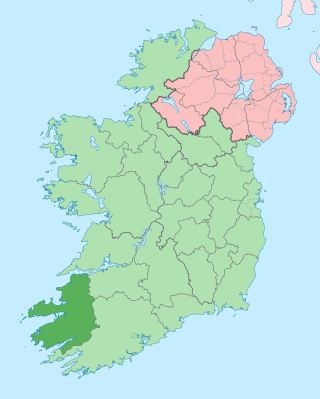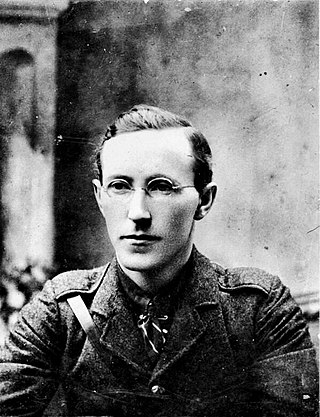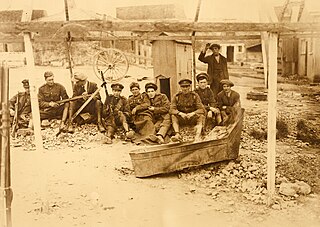
County Kerry is a county on the southwest coast of Ireland, within the province of Munster and the Southern Region. It is bordered by two other counties; Limerick to the east, and Cork to the south and east. It is separated from Clare to the north by the Shannon Estuary. With an area of 4,807 square kilometres (1,856 sq mi) and a population of 156,458 as of 2022, it is the 5th largest of Ireland's 32 counties by land area, and the 15th most populous. The governing local authority is Kerry County Council.

Kilflynn is a village and a civil parish in north County Kerry, Ireland. It is 11 km north-east of Tralee just off the N69 road from Tralee to Listowel.
Events from the year 1922 in Ireland.

Abbeydorney is a village in County Kerry, Ireland. Located 9 kilometres (6 mi) north of the county town of Tralee, the village had a population of 418 as of the 2016 census of Ireland. Abbeydorney falls within the civil parish of O'Dorney, and is sometimes colloquially called by that name.

William Fanaghan Lynch was an Irish Republican Army officer during the Irish War of Independence of 1919–1921. During much of the Irish Civil War, he was chief of staff of the Irish Republican Army. On 10 April 1923, Lynch was killed whilst trying to escape an encirclement by Free State troops in south Tipperary.

The Irish Free State offensive of July–September 1922 was the decisive military stroke of the Irish Civil War. It was carried out by the National Army of the newly created Irish Free State against anti-treaty strongholds in the south and southwest of Ireland.

The Battle of Dublin was a week of street battles in Dublin from 28 June to 5 July 1922 that marked the beginning of the Irish Civil War. Six months after the Anglo-Irish Treaty ended the recent Irish War of Independence, it was fought between the forces of the new Provisional Government and a section of the Irish Republican Army (IRA) that opposed the Treaty.

The executions during the Irish Civil War took place during the guerrilla phase of the Irish Civil War. This phase of the war was bitter, and both sides, the government forces of the pro-treaty Irish Free State and the anti-Treaty Irish Republican Army (IRA) insurgents, used executions and terror in what developed into a cycle of atrocities. From November 1922, the pro-treaty provisional later Free State government embarked on a policy of executing Republican prisoners in order to bring the war to an end. Many of those killed had previously been allies, and in some cases close friends, of those who ordered their deaths in the civil war. In addition, government troops also summarily executed at least 130 prisoners in the field. The executions of prisoners left a lasting legacy of bitterness in Irish politics.
Stephen Fuller was an Irish Fianna Fáil politician who served as a Teachta Dála (TD) for the Kerry North constituency from 1937 to 1943.
This is a timeline of the Irish Civil War, which took place between June 1922 and May 1923. It followed the Irish War of Independence (1919–1921), and accompanied the establishment of the Irish Free State as an entity independent from the United Kingdom of Great Britain and Ireland.

The guerrilla phase of the Irish Civil War began in August 1922, when the forces of the Irish Free State took all the fixed positions previously held by the Anti-Treaty IRA. The IRA then waged a guerrilla war to try to bring down the new Irish Government and overturn the Anglo-Irish Treaty. This guerrilla campaign was ultimately defeated.

The National Army, sometimes unofficially referred to as the Free State Army or the Regulars, was the army of the Irish Free State from January 1922 until October 1924. Its role in this period was defined by its service in the Irish Civil War, in defence of the institutions established by the Anglo-Irish Treaty. Michael Collins was the army's first commander-in-chief until his death in August 1922.

Gortclohy is a townland of County Kerry, Ireland.

Fahavane is a townland of County Kerry, Ireland.

George O'Shea was an Irish Republican Army (IRA) soldier who fought with the Anti-Treaty side during the Irish Civil War. He was one of eight men killed by Free State forces in the Ballyseedy Massacre, a defining event in Irish history.
Reginald Walter Stenning was a British Army deserter who joined the Irish Republican Army (IRA), fighting on the anti-Treaty side in the Civil War. After being captured by Free State forces he was beaten and executed.
James McEnery was a farmer and IRA soldier who fought on the anti-Treaty side in the Irish Civil War in north Kerry. He surrendered during a three-day siege by Free State forces, in the last significant action of the War, and was executed seven days later.
Edmond Greaney [also 'Edward', 'Eamonn/Eamon' and 'Greany' on historical documents] was a farm labourer and IRA soldier who fought on the anti-Treaty side in the Irish Civil War in north Kerry. He was captured by Free State forces and executed after the last major action of the War.
Thomas McGrath was an IRA soldier who fought on the anti-Treaty side in the Irish Civil War in north Kerry. He drowned after trying to escape a siege by Irish Free State forces at Clashmealcon during what was the last major military action of the War.
Patrick O'Shea was a farm labourer and IRA soldier who fought on the anti-Treaty side during the Irish Civil War in north Kerry. He died after falling from a cliff trying to escape from Irish Free State forces in a siege at Clashmealcon in the last major military action of the civil war.













